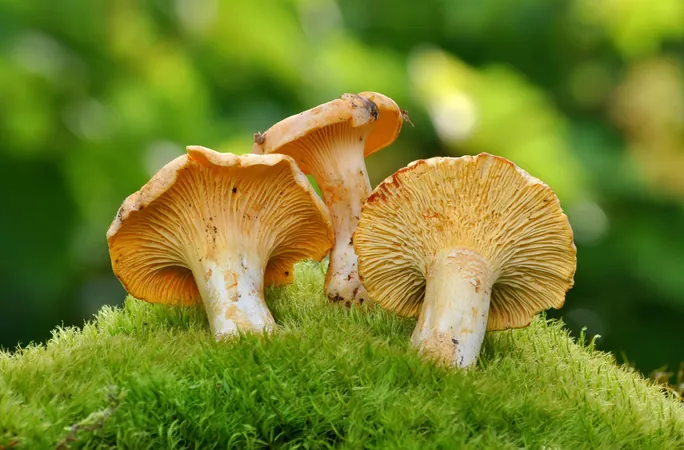
Unveiling the Hidden World: How Urbanization Alters Soil Bacteria and Fungi Differentiate Their Roles
2025-04-03
Author: Rajesh
Urbanization and Soil Transformation
Urbanization is changing landscapes in profound ways—and it’s not just the towering skyscrapers and bustling streets that we should be worried about. Beneath our feet, the soil is undergoing a remarkable transformation, particularly in the invisible communities of bacteria and fungi that play vital roles in ecosystems.
Recent groundbreaking research from scientists at Shanghai Jiao Tong University, the University of Helsinki, and a collaboration of other institutions reveals that while bacteria are rapidly adjusting to urban environments, fungi are maintaining their distinct characteristics. This contrast may have significant implications for urban ecology and soil health.
The study investigated soil microbial communities across diverse biomes—boreal, temperate, and tropical—and assessed sites ranging from untouched forests to urban parks of varying ages. The results illustrated a striking divergence in how these two groups respond to urban pressures.
Bacteria: Adaptable Generalists in Action
The findings indicate that soil bacteria in urban settings are behaving like generalists, quickly adapting to a variety of conditions. The similarity between bacterial communities increased significantly from 79% in undisturbed forests to 85% in younger urban parks, with a staggering 90% identified as generalists.
Bacteria's ability to exchange genetic material easily enables them to thrive despite rapid changes, making them pivotal players in maintaining the soil health of our cities.
Fungi: Stalwarts of Specialization
In contrast, fungi exhibited remarkable resilience to urban change. Approximately 83% of fungal species studied were identified as specialists, remaining closely tied to specific environmental conditions. Their slower evolutionary pace, coupled with a complex network of mycelia that connects them to their environment, makes them less adaptable compared to bacteria.
Dr. Nan Hui, the study's lead researcher, emphasized the importance of understanding these dynamics, stating, "Urbanization is a powerful force reshaping soil microbial communities, yet bacteria and fungi respond in strikingly different ways. This highlights a complex interplay between microbial adaptation and ecosystem resilience."
The Synergy of Bacteria and Fungi in Urban Soils
Despite their differing strategies, both soil bacteria and fungi are essential for maintaining healthy ecosystems. They collaborate to break down organic matter and recycle vital nutrients, ensuring that urban soils remain functional. The study suggests a degree of redundancy in their ecological roles, indicating that even as populations shift, essential soil functions can still be preserved.
This inherent resilience provides a glimmer of hope for urban planners and environmental managers. With appropriate strategies and support, urban soils can continue to thrive, adapting and sustaining ecosystems even in highly modified environments.
Future Perspectives on Urban Soil Health
Soil microbes are frequently overlooked in discussions about biodiversity, especially in urban settings. However, this research underscores their critical role in sustaining life above ground. Understanding how these microorganisms respond to urbanization is crucial for cultivating resilient cities.
Future research avenues could include examining how various urban design choices—such as the age of green spaces or selection of plant species—impact microbial communities. Such studies can inform the development of urban environments that bolster biodiversity, combat climate change, and promote sustainability.
As we deepen our understanding of the tiny inhabitants that keep our urban soils alive, we equip ourselves with the knowledge to nurture the ecosystems that support our lives, even in the chaotic heart of the city. It's a reminder that the battle for urban sustainability is fought not only in the visible realm but also in the unseen world beneath our feet.
The full findings from this enlightening study have been published in the journal Environmental Science and Ecotechnology. Join us in uncovering the hidden wonders of urban soil life!




 Brasil (PT)
Brasil (PT)
 Canada (EN)
Canada (EN)
 Chile (ES)
Chile (ES)
 Česko (CS)
Česko (CS)
 대한민국 (KO)
대한민국 (KO)
 España (ES)
España (ES)
 France (FR)
France (FR)
 Hong Kong (EN)
Hong Kong (EN)
 Italia (IT)
Italia (IT)
 日本 (JA)
日本 (JA)
 Magyarország (HU)
Magyarország (HU)
 Norge (NO)
Norge (NO)
 Polska (PL)
Polska (PL)
 Schweiz (DE)
Schweiz (DE)
 Singapore (EN)
Singapore (EN)
 Sverige (SV)
Sverige (SV)
 Suomi (FI)
Suomi (FI)
 Türkiye (TR)
Türkiye (TR)
 الإمارات العربية المتحدة (AR)
الإمارات العربية المتحدة (AR)